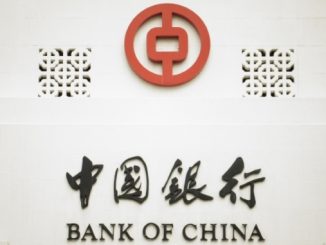
With investors showing a growing interest in SRI, the topic has become one for covered bonds, and in September Münchener Hypothekenbank launched the first benchmark issue to carry a sustainability rating. Here, Franz Rudolf, head of financials credit research at UniCredit, explores what the relevant rating agencies are looking for.
 This article originally appeared in the September/October 2013 issue of The Covered Bond Report magazine.
This article originally appeared in the September/October 2013 issue of The Covered Bond Report magazine.
Sustainability is a rather new topic in the banking industry. It comprises a broad range of topics but lacks clear definition. It includes the handling of natural resources by banks (ranging from the amount of paper used within an entity to “green buildings”), exposure to certain industry sectors, as well as corporate social responsibility towards clients and personnel. Nevertheless, in recent years, the share of investors with a specific focus on socially responsible investment (SRI) has steadily increased. Interest in SRI has grown across investor types, including asset managers, banks, insurance and pension funds as well as central banks. In addition, religious institutions and charities, particularly in Germany, have shown great interest.
Increasing interest in SRI funds
Over the past few years, demand and thus the invested volume in SRI funds have steadily increased. As of June 2012, there were 884 green, social and ethical funds domiciled in Europe (SRI retail funds), according to the rating agency Vigeo. Assets under management reached almost Eu95bn, representing around 1.6% of the total retail funds market in Europe. France has the highest share with 44% of assets, followed by the UK with 14%, Switzerland with 10%, Belgium with 8%, and Germany with 7%. These five countries make up 83% of total SRI retail funds. The average size of SRI retail funds is around Eu107m, with fixed income funds being the largest (Eu245m), followed by equity funds (Eu106m) and balanced funds (Eu82m).
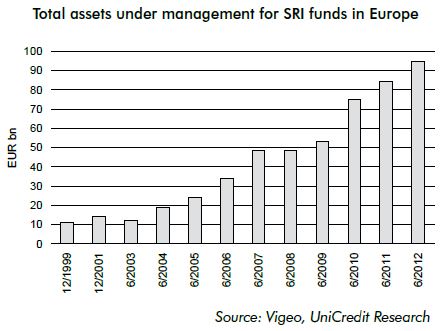
While there are no detailed statistical data available with respect to the share of covered bonds with a sustainability background of their issuers, the data on fixed income assets in general (in comparison to equity or real estate) with a sustainability orientation increased. Fixed income assets, especially in Austria, Italy and Germany, contribute more than half of the SRI market asset allocation.
Investments allocated to SRIs are dominated by institutional investors, with a share of around 94%. The type of institutional investors varies strongly among countries. While in France, private insurers make up the largest part with 39%, followed by pension funds (20%) and public funds (18%), the share of foundations, charities, religious organizations and NGOs is only 3%. This is in contrast to Germany, where religious institutions and charities dominate with 49%, followed by endowments & foundations with 18%, and corporate/occupational pension funds with 13%.
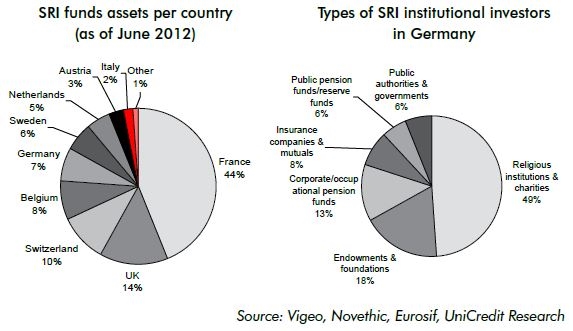
From “Green Bonds”…
In the context of bonds, “green bonds” have been well established in capital markets and typically refer to bonds where the proceeds go towards a climate-change solution. This initiative was driven by the World Bank, the EU and EIB. The European Union and its long-term financing institution, the EIB, have made climate change mitigation and adaptation a key topic. The EIB supports the EU’s goal of low-carbon and climate-resilient growth within and outside the union through special lending facilities. In 2007, the bank was the first to launch a climate-themed bond with proceeds earmarked for projects supporting climate action: the Climate Awareness Bond (CAB). The funds raised via Climate Awareness Bonds are earmarked for disbursement to EIB lending projects within the fields of renewable energy and energy efficiency.
…to covered bonds
The activities of banks in the area of mortgage loans and infrastructure finance builds the bridge between sustainability and covered bonds. Banks’ financing of real estate and infrastructure gives them considerable scope to influence the establishment of environmental and social standards in these areas. Transparency of their business processes and products and the long-term focus of their business models are key elements in approaching sustainability issues. However, there are no sustainability ratings specifically for covered bonds yet. In order to help investors evaluate the efforts of banks with respect to sustainability, a number of rating agencies have emerged. Players in this field are, among others, oekom research, imug, Vigeo, and Sustainalytics.
Rating agencies’ approach to sustainability
To illustrate the rating approach and its criteria with respect to sustainability, we take oekom research’s rating methodology as an example. oekom research’s Financials/Mortgage & Public Sector Finance universe comprises 53 companies from 15 countries, including 14 companies based in Germany, seven in the US, six in France and four in Ireland. The oekom corporate rating focuses on how environmental and social aspects are taken into account in the lending business. oekom research uses a pool of over 500 indicators, of which the most relevant criteria per sector (up to 100) are selected. The oekom corporate rating has two dimensions, social rating and environmental rating, with six categories. The assessment fields in the mortgage and public sector finance sector are as follows:
Social rating
- Staff (freedom of association, work-life balance, safeguarding of jobs, health and safety, equal opportunities, training and education) and suppliers (standards, monitoring);
- Society (human rights, community involvement, governmental relations and public advocacy, stakeholder dialogue) and product responsibility (marketing, sales practices, treatment of customers with debt repayment problems, financial services with high social benefit, sale of mortgage loan portfolios);
- Corporate governance (independence and effectiveness of the board, shareholder democracy, executive compensation, transparency on shareholder structure) and business ethics (code of conduct, implementation of the code);
Environmental rating
- Environmental management (policy, management system, reporting, performance indicators, climate change strategy, travel and transport);
- Products & Services (credit rating process for public sector and commercial clients, residential mortgages and private clients, ESG (environmental, social, governance) criteria in the company’s own investments);
- Eco-efficiency (consumption of energy, water, paper, greenhouse gas emissions, total waste, recycled waste, business travel).
Oekom research is not paid by issuers, but by investors. Therefore, the level of information provided to oekom research may vary from bank to bank, depending on whether they are willing to get actively involved in a sustainability rating or if oekom research has to base its analysis on publicly-available information. oekom research follows a two-stage model, with the first stage, the oekom research corporate scouting, being the screening of companies on the basis of publicly-available information. In the second step, the companies are evaluated using the oekom corporate rating process. Although oekom research does not assign a specific covered bond sustainability rating, the issuers of covered bonds receive sustainability ratings.
According to oekom research’s Industry Focus on financials/mortgage & public sector finance from March 2013, eight companies or 15% of the analyzed companies received prime status. The top three companies were Kommunalkredit Austria (C+), SBAB Bank (C), and Deutsche Pfandbriefbank (C). The average score of all companies analysed (53) was D+.
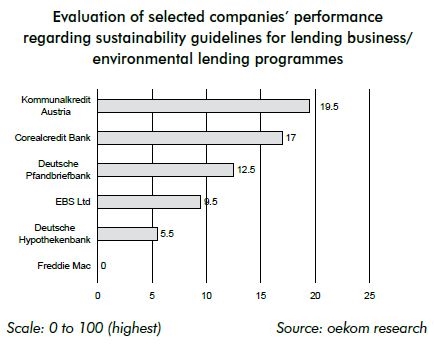
Overall, the best company in oekom research’s financials/mortgage & public sector finance rating universe, Kommunalkredit Austria, achieved a score of C+ on the rating scale. oekom research has awarded prime status to a total of eight companies, which is equivalent to 15.1% of all the companies analysed. Prime status distinguishes those companies that are among the leaders in their sector in terms of sustainability and which fulfill the minimum requirements defined by oekom research for a specific industry. The prime threshold for this industry is C, and the average score for all the companies analyzed was D+.
In its sector analysis, oekom research rated 53 banks.
However, oekom research does not publish the ratings of all these banks. Transparency standards have not yet developed to the point that all issuers make their sustainability ratings — from whatever rating company — available on their company webpage. The scope ranges from posting the full rating reports from several rating agencies to not mentioning it at all. We expect this to improve over time as sustainability issues gain in importance for market participants.
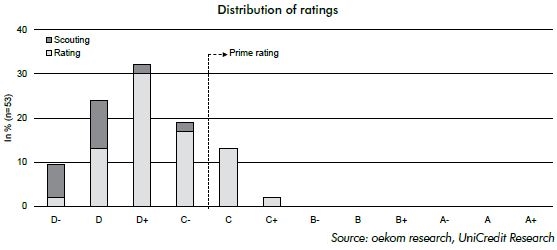
Lead photo: Deutsche Pfandbriefbank (pbb)

